
Paolo Uccello, born Paolo di Dono, was a Florentine painter and mathematician who was notable for his pioneering work on visual perspective in art. In his book Lives of the Most Excellent Painters, Sculptors, and Architects, Giorgio Vasari wrote that Uccello was obsessed by his interest in perspective and would stay up all night in his study trying to grasp the exact vanishing point. While his contemporaries used perspective to narrate different or succeeding stories, Uccello used perspective to create a feeling of depth in his paintings. His best known works are the three paintings representing the battle of San Romano, which were wrongly entitled the Battle of Sant'Egidio of 1416 for a long period of time.

Giorgione was an Italian painter of the Venetian school during the High Renaissance, who died in his thirties. He is known for the elusive poetic quality of his work, though only about six surviving paintings are firmly attributed to him. The uncertainty surrounding the identity and meaning of his work has made Giorgione one of the most mysterious figures in European art.

Willem Drost was a Dutch Golden Age painter and printmaker of history paintings and portraits.

Robert Campin, now usually identified with the Master of Flémalle, was the first great master of Flemish and Early Netherlandish painting. Campin's identity and the attribution of the paintings in both the "Campin" and "Master of Flémalle" groupings have been a matter of controversy for decades. Campin was highly successful during his lifetime, and thus his activities are relatively well documented, but he did not sign or date his works, and none can be confidently connected with him.

Hans Fredrik Gude was a Norwegian romanticist painter and is considered along with Johan Christian Dahl to be one of Norway's foremost landscape painters. He has been called a mainstay of Norwegian National Romanticism. He is associated with the Düsseldorf school of painting.

Saint Praxedis is an oil painting attributed to Johannes Vermeer. This attribution has often been questioned. However, in 2014 the auction house Christie's announced the results of new investigations which in their opinion demonstrate conclusively that it is a Vermeer. The painting is a copy of a work by Felice Ficherelli, and depicts the early Roman martyr, Saint Praxedis or Praxedes. It may be Vermeer's earliest surviving work, dating from 1655.

Fra Carnevale OP was an Italian painter of the Quattrocento, active mainly in Urbino. Widely regarded as one of the most enigmatic artists, there are only nine works that can be definitively attributed to Carnevale known of today. Most of these have even been contested as authentic to Carnevale at various points in history.

The Master of the Life of the Virgin, in German the Meister des Marienlebens,, is the pseudonym given to a late Gothic German painter working in Cologne. He can also be known as the Master of Wilten, or Johann van Duyren, an identification not universally accepted.
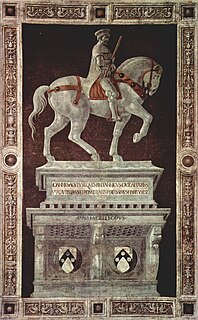
The Funerary Monumentto SirJohn Hawkwood is a fresco by Paolo Uccello, commemorating English condottiero John Hawkwood, commissioned in 1436 for Florence Cathedral. The fresco is an important example of art commemorating a soldier-for-hire who fought in the Italian peninsula and is a seminal work in the development of perspective.

The Master of Ambrass was a Bohemian painter active probably in Prague at the end of the fourteenth century. He was the creator of the Wiener Musterbuch, a set of silverpoint studies and subjects all dated to the same period, which were used as models in painters' studios. Among the subjects are bust-length images of Christ, the Virgin, various saints, the Crucifixion, and the Annunciation. The pictures are collected in groups of four, affixed to fourteen small framed panels. Three independent designs also exist, depicting a philosopher and astronomer, a sibyl and John the Evangelist, and the Three Magi; these, too, were probably part of the set. Such is the realism of the designs that it is believed the Master had contact with an artist of the Franco-Flemish school. Also attributed to his hand, dubiously, is an Annunciation at the Fogg Art Museum in Cambridge, Massachusetts.

Jan Wellens de Cock was a Flemish painter and draftsman of the Northern Renaissance.
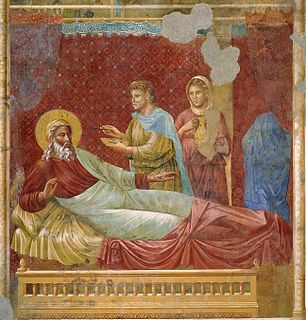
The Isaac Master was an Italian Gothic painter active in the decoration of the Basilica of San Francesco d'Assisi in Assisi at the end of the thirteenth century. Master's name is derived from a fresco painting of the death of Isaac for which he is known, the fresco is located in the Upper Church of St Francis at Assisi, depicting Isaac blessing Jacob and Esau.

Trophime Bigot (1579–1650), also known as Théophile Bigot, Teofili Trufemondi, the Candlelight Master, was a French painter of the Baroque era, active in Rome and his native Provence.
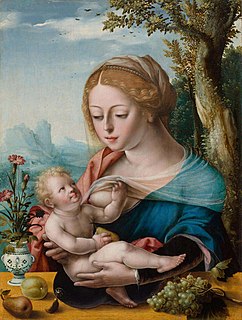
The Master with the Parrot or Master of the Parrot is the notname given to a group of Flemish painters who likely worked in a workshop in Antwerp in the first half of the 16th century. They produced devotional pictures for the local bourgeoisie in a style reminiscent of contemporary Flemish painters working in an Italianate style.
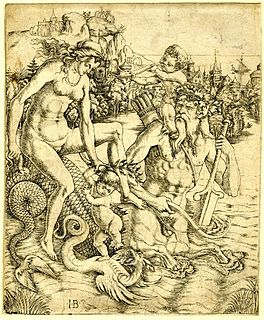
Giovanni Battista Palumba, also known as the Master I.B. with a Bird, was an Italian printmaker active in the early 16th century, making both engravings and woodcuts; he is generally attributed with respectively 14 and 11 of these. He appears to have come from northern Italy, but later worked in Rome. He specialized in subjects from classical mythology, as well as the inevitable religious subjects. Despite his relatively small output, he was a sophisticated artist, whose style shows a number of influences and changes, reflecting awareness of the currents in artistic style at the start of the High Renaissance. The signed prints are usually dated to around 1500–1511.
Antonia di Paolo di Dono (1456–1491) was the daughter of Paolo di Dono, nicknamed Uccello, a well-known early Renaissance Florentine painter. Giorgio Vasari's biography of Uccello states that he had "a daughter who knew how to draw." Antonia was recorded in the Libro dei Morti of the painter's guild, Arte dei Medici e Speziali, as a "pittoressa." This was the first time the feminine form of the word "painter" appears in Florentine public records and the first formal recognition of a fifteenth-century woman artist.
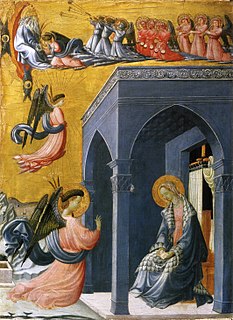
Annunciation is a gold and tempera on panel painting by Paolo Uccello executed c. 1425. It is now in the Ashmolean Museum in Oxford, England, to which it was given by William Thomas Herner Fox-Strangways in 1850.

The Jester Calabacillas is a 1626-1632 oil on canvas painting by Diego Velázquez, now in the Cleveland Museum of Art. Its attribution is based on stylistic similarities to other works by the artist - for example, José López-Rey sees similarities in the treatment of the face in this work and that of Bacchus in The Triumph of Bacchus. Its subject is thought to be the jester Juan Calebasse, also painted by the artist in a work now in Madrid and a now-lost work entitled "calebasses in a turban", the latter recorded in 1642 and 1655 inventories of Diego Felipez de Guzmán's collection.

















